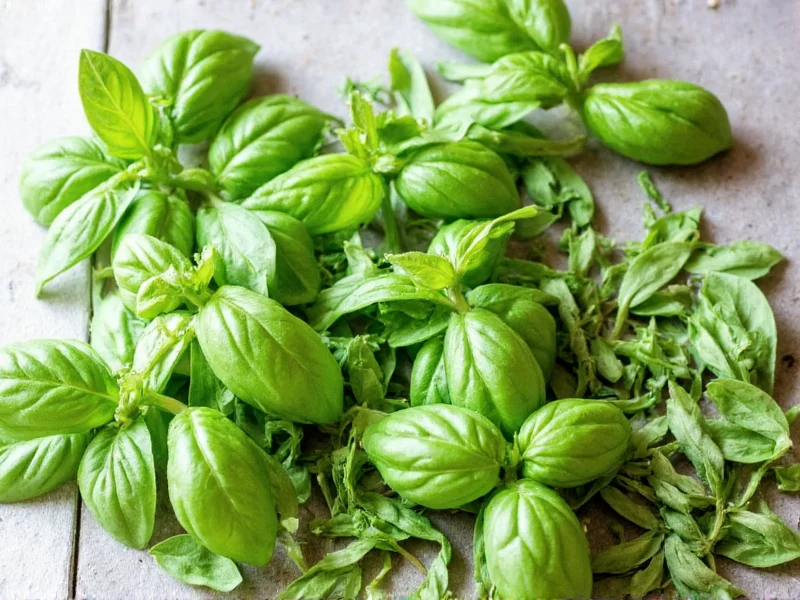When converting fresh basil to dried basil, use a 3:1 ratio—meaning 3 parts fresh basil equals 1 part dried basil. This accounts for the 90% water content lost during drying, which concentrates the flavor compounds. Properly dried basil retains essential oils better when dried slowly at low temperatures (below 100°F/38°C) and stored in airtight containers away from light.
Understanding the conversion between fresh and dried basil is essential for precise cooking and preserving your herb harvest. The difference stems from water content: fresh basil contains approximately 90% water, while dried basil has only about 10%. This significant moisture reduction concentrates the flavor compounds, making dried basil more potent by volume.
Why the 3:1 Conversion Ratio Matters
The 3:1 ratio (three parts fresh to one part dried) isn't arbitrary—it's based on the physical transformation that occurs during drying. When you remove moisture from fresh basil leaves, you're concentrating the essential oils and flavor compounds. Using equal amounts would result in either a weak flavor (using too little dried basil) or an overpowering, sometimes bitter taste (using too much).
| Measurement | Fresh Basil | Dried Basil Equivalent |
|---|---|---|
| Teaspoon | 1 tablespoon | 1 teaspoon |
| Tablespoon | 3 tablespoons | 1 tablespoon |
| Cup | 3 cups loosely packed | 1 cup |
| Ounce by weight | 1 ounce | 0.33 ounce |
Effective Methods for Drying Fresh Basil
Drying technique significantly impacts the final flavor quality of your basil. Professional chefs and home cooks have several options, each with distinct advantages:
Air Drying (Traditional Method)
This slow method preserves more volatile oils than faster techniques. Bundle 5-6 stems together and hang them upside down in a dark, warm (70-80°F/21-27°C), well-ventilated area with 40-50% humidity. Complete drying takes 1-2 weeks. The slow dehydration process maintains more of the herb's complex flavor profile compared to rapid drying methods.
Oven Drying (Controlled Environment)
For more consistent results, use your oven on the lowest setting (ideally below 100°F/38°C). Spread leaves in a single layer on a baking sheet lined with parchment paper. Prop the oven door open slightly to allow moisture escape. Check every 30 minutes until leaves crumble easily (typically 2-4 hours). This method offers better temperature control than air drying but requires more attention.
Dehydrator Method (Most Consistent Results)
Food dehydrators provide the most controlled environment for drying herbs. Set to 95°F (35°C) and dry for 2-4 hours until leaves become brittle. The consistent, low-temperature airflow preserves maximum flavor compounds while ensuring complete moisture removal, preventing mold during storage.
Maximizing Flavor Retention During Drying
Research shows that basil's essential oils—particularly eugenol, linalool, and estragole—are sensitive to heat and light. To preserve maximum flavor:
- Harvest basil in the morning after dew evaporates but before intense sun
- Avoid washing leaves if possible; if necessary, dry thoroughly before processing
- Keep drying temperatures below 100°F (38°C) to prevent volatile oil evaporation
- Store dried basil immediately in airtight containers away from light
Storage Techniques for Long-Lasting Flavor
Proper storage determines how long your dried basil maintains peak flavor. Exposure to light, air, and moisture rapidly degrades quality:
| Storage Method | Flavor Duration | Key Considerations |
|---|---|---|
| Air-tight glass jar in dark pantry | 12-18 months | Best option for home storage; use amber or cobalt glass for light protection |
| Vacuum-sealed container | 18-24 months | Removes oxygen that degrades essential oils; ideal for bulk storage |
| Refrigerator in sealed container | 6-9 months | Higher humidity may reduce shelf life; only recommended in humid climates |
| Freezer in vacuum-sealed bag | 24+ months | Best long-term option; prevents flavor degradation almost completely |
Flavor Differences Between Fresh and Dried Basil
Understanding the flavor profile differences is crucial for successful substitution in recipes. Fresh basil offers bright, sweet notes with hints of anise and clove, while dried basil develops more earthy, slightly minty characteristics. The drying process alters the chemical composition:
- Fresh basil contains higher levels of linalool (floral notes)
- Drying increases eugenol concentration (spicier, clove-like notes)
- Some volatile compounds evaporate during drying, changing the overall profile
Recipe Substitution Guidelines
When substituting dried basil for fresh (or vice versa), consider both the conversion ratio and the dish's cooking method:
- Long-simmered dishes (sauces, soups, stews): Add dried basil early to allow flavors to meld; use 1 teaspoon dried per tablespoon fresh called for
- Quick-cooking dishes (salads, garnishes, fresh sauces): Fresh basil is preferable; if substituting dried, use half the standard ratio and add at the very end
- Raw applications (pesto, dressings): Fresh basil is essential; dried won't provide the same texture or bright flavor
- Baked goods (savory breads, focaccia): Dried basil works well; use the standard 3:1 conversion
Common Drying Mistakes to Avoid
Many home cooks make these errors when converting fresh basil to dried:
- Using high heat: Temperatures above 100°F (38°C) cause rapid oil evaporation
- Inadequate drying: Leaving too much moisture leads to mold during storage
- Improper storage: Clear containers exposed to light degrade flavor compounds
- Over-packing storage containers: Trapped moisture accelerates spoilage
- Using old dried basil: Flavor degrades significantly after 18 months even with proper storage
When to Choose Fresh vs. Dried Basil
Culinary experts recommend selecting based on the dish's requirements:
- Use fresh basil when: Making pesto, caprese salad, garnishing finished dishes, or in any raw application where bright flavor and visual appeal matter
- Use dried basil when: Creating long-simmered tomato sauces, soups, stews, or spice blends where its concentrated flavor can develop over time











 浙公网安备
33010002000092号
浙公网安备
33010002000092号 浙B2-20120091-4
浙B2-20120091-4